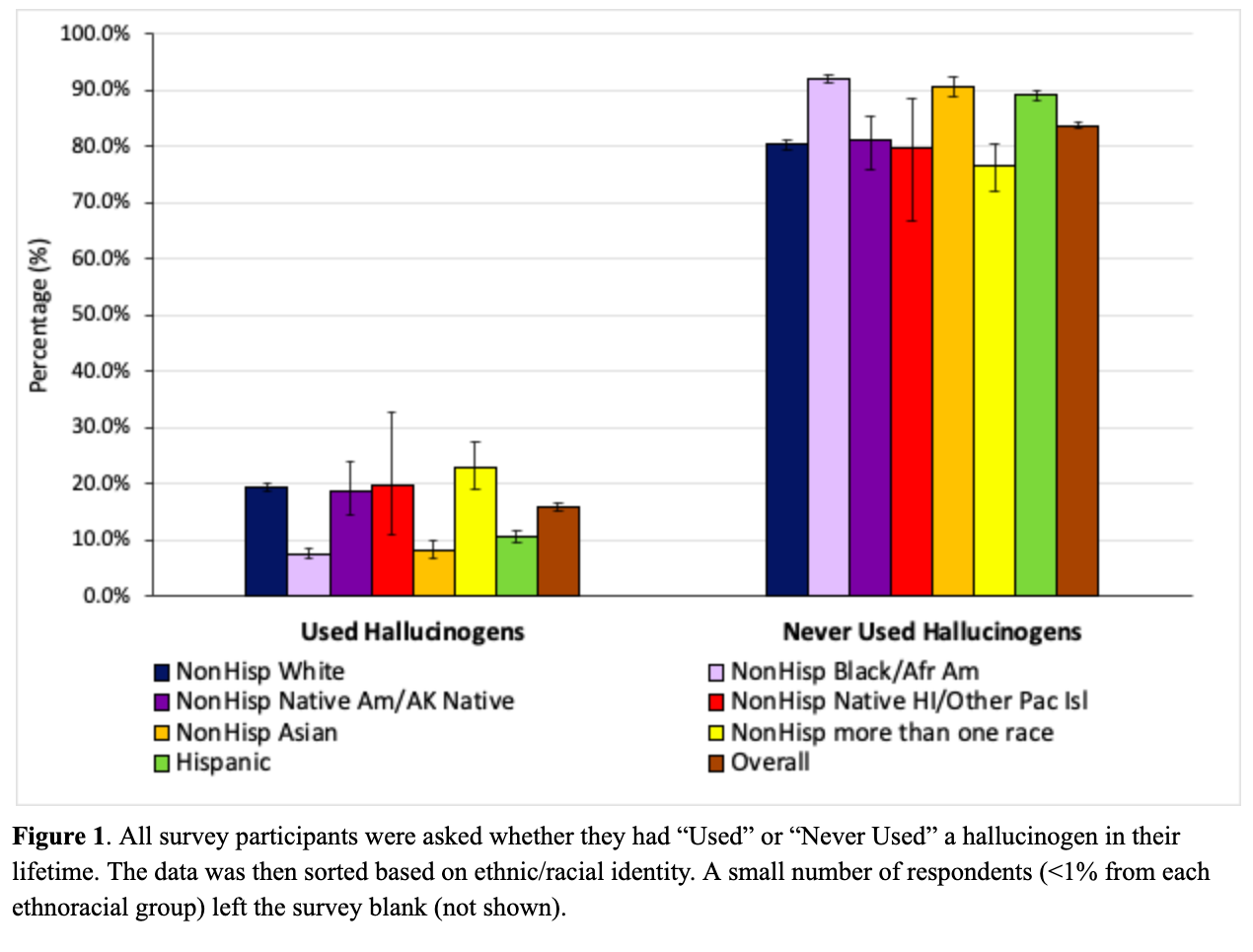Psychedelic Science
Hallucinogen Use by Race/Ethnicity & Age
From the 2018 National Survey on Drug Use and Health
Considering the re-emergence of psychedelics within medical and recreational communities, population trends in hallucinogen use have become increasingly relevant. To date, few studies have assessed the epidemiology of hallucinogenic substance use among different racial and ethnic groups. The use of psychedelic substances may differ among people of colour (POC), due to factors such as stigma and discriminatory drug enforcement practices against POC. The lack of inclusion of POC in recent psychedelic research further underscores the importance of identifying differences in use among racial/ethnic groups and age cohorts in the general U.S. population.
Data from the National Survey on Drug Use and Health, which is partnered with the Substance Abuse and Mental Health Services Administration (SAMHSA), was used for this analysis (N=56,313). Proportions were compared using crosstabs in order to examine differences in lifetime and past year use of hallucinogens (LSD, PCP, peyote, mescaline, psilocybin, MDMA, ketamine, DMT, and salvia) by race/ethnicity (Non-Hispanic White; Black or African American; AIAN [American Indian or Alaska Native]; NH [Native Hawaiian or Other Pacific Islander]; Asian; Two or More Races, and Hispanic or Latino) and age cohort (12-17, 18-25, 26-34, 35-49, 50+).
Understanding Naturalistic Use of Psychedelics
Approximately 15.9% of the U.S. population aged 12 and over had used a hallucinogen at some point in their lifetime, and 2.0% had used in the past year. Over all races/ethnicities, lifetime use was highest in people aged 50+ (36.9%) and lowest in 12-17 year olds (1.2%). Past year use was highest in people aged 18-25 (41.3%) and lowest in 12-17 year olds (6.5%) and 50+ (6.5%). Over all age groups, lifetime use was highest in non-Hispanic White (76.1%) and lowest in NH (0.5%). Past year use was highest in non-Hispanic White (67.8%) and lowest in NH (0.3%). Patterns of lifetime and past year use also differed by age cohort and race/ethnicity. For example, Non-Hispanic African Americans aged 18-25 (32.2%) were less likely to report past year hallucinogen use than any other racial group of the same age cohort. By contrast, Non-Hispanic Asians of the age group 18-25 (20.8%) were more likely to report lifetime hallucinogen use than any other group of the same age cohort.
Differences in lifetime and past year hallucinogen use among ethnoracial groups by age cohorts were found in the 2018 survey data. Differences in patterns of use by specific substance as well as substance abuse and dependence emerged. Findings from this work may inform current and future culturally-diverse substance use education and therapeutic psychedelic research.
Findings
In a survey of all respondents, 15.9% of the population reported that they had used hallucinogens in their lifetime. Non-Hispanic, multi-racial groups reported the highest percentage of past hallucinogen use (23.0%). Non-Hispanic Hawaiian and other Pacific Islander groups reported the second highest usage (19.8%), while Non-Hispanic White respondents reported the third highest usage (19.4%). Furthermore, Hispanic, Asian, and African American groups reported the lowest percentage of use (10.6%, 8.3%, and 7.6%, respectively). Proportions for all age cohorts and ethnoracial identities are detailed in the Figure below. Data is cross-sectional and self-reported.

Papers
Davis, A. K., Arterberry, B. J., Xina, Y., Agin-Liebese, G., Schwarting, C., & Williams, M. T. (2022). Race, ethnic, and sex differences in prevalence of and trends in hallucinogen consumption among lifetime users in the United States between 2015-2019. Frontiers in Epidemiology, 2, 876706. https://doi.org/10.3389/fepid.2022.876706
Jahn, Z. W., Lopez, J., de la Salle, S., Faber, S., & Williams, M. T. (2021). Racial/Ethnic differences in prevalence for hallucinogen use by age cohort: Findings from the 2018 National Survey on Drug Use and Health. Journal of Psychedelic Studies, 5(2), 69-82. https://doi.org/10.1556/2054.2021.00166